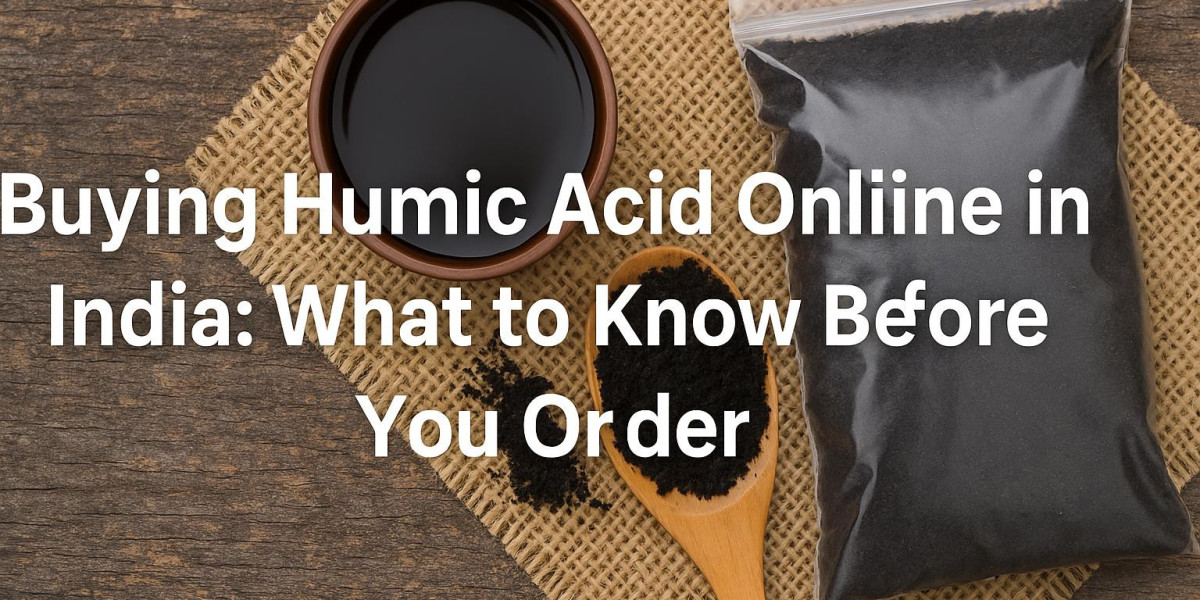Let’s dig deep—what should Indian farmers, gardeners, and agri-retailers really know before clicking “buy”?
What Is Humic Acid and Why Is It Gaining Ground?
Humic acid is a naturally occurring organic substance formed through the decomposition of plant and animal matter over millions of years. It plays a pivotal role in improving soil structure, increasing microbial activity, and enhancing nutrient uptake in plants. In India, where diverse soil types often face issues like salinity, compaction, and nutrient leaching, humic acid can offer a much-needed regenerative solution.
Statistically, over 40% of Indian farmlands have shown signs of nutrient deficiency, especially in micronutrients. This is where humic acid steps in—not as a fertilizer substitute, but as a catalyst that helps plants absorb nutrients more effectively.
The Grades and Forms
Before purchasing humic acid online, it’s crucial to know that not all humic acid products are the same. They come in many grades and forms depending on concentration, solubility, and provenance.
Liquid Form: Often easier to apply through fertigation systems or foliar sprays. Quick absorption.
Powder or Flake Form: Suitable for bulk use, especially when integrated into soil conditioners or compost mixes.
One standout option for advanced users is HUBEL - humic acid 98% potassium humate, known for its high concentration and solubility. When choosing such high-grade products, be sure the source is trustworthy and well-reviewed in farming communities.
Key Things to Check Before Buying
Source & Origin
Humic acid can be derived from various sources, such as leonardite, peat, or lignite. Leonardite-based humic acid is considered superior due to its high carbon content and stability. Products sourced from verified leonardite deposits offer higher bioavailability and better plant response.
Solubility & pH Compatibility
Solubility and pH balance are crucial for Indian soils, especially the alkaline ones found in parts of Gujarat, Rajasthan, and Maharashtra. Some products may not dissolve entirely in water, reducing efficiency when applied through irrigation systems.
Check for 100% water-soluble labels.
Confirm compatibility with your irrigation method (drip, spray, flood, etc.)
Certifications & Quality Testing
Any product worth buying should be backed by third-party lab reports or certifications, especially if you're managing organic farmland. Look for:
ISO or FCO compliance
Lab-tested carbon and fulvic content
Absence of heavy metals or contaminants
Navigating Online Sellers and Marketplaces
Buying humic acid online offers benefits like price comparison, doorstep delivery, and access to niche brands. However, Indian e-commerce platforms are flooded with options, many lacking transparency.
Ask these questions before choosing an online seller:
Do they mention the percentage of humic or potassium humate content?
Is a Material Safety Data Sheet (MSDS) or lab report available?
Are customer reviews specific and agriculture-focused?
Does the seller support bulk orders or offer agronomic advice?
Packaging and Storage: Why It Matters
You might find attractive prices for 5kg or even 25kg humic acid packs online, but what about shelf life? Improper packaging can lead to caking, moisture absorption, and reduced potency. Always choose packaging that is:
Moisture-resistant and resealable
Labeled with batch numbers and manufacturing dates
Even top-grade humic acid can degrade quickly if stored in humid conditions. A cool, dry storage area can preserve its efficiency for over a year.
The Price Factor: Are You Really Saving?
Depending on its quality, content, and form, humic acid can cost anywhere between ₹200 and ₹1200 per kilogram in India. Online retailers could provide discounts or package offers for purchases of five kg. Although cost is an issue, solubility and efficacy should always come first.
Easy access to specialty items like humic acid has led to a 30% increase in online sales of organic agri-inputs in India since 2023, according to recent market data. However, how well a product fits into your crop plan determines how cost-effective it is
“Healthy soil isn’t an expense. It’s a long-term investment that pays back in yields.”
Application Dosage and Timing: Reading Between the Lines
When you buy humic acid online, you’re often left with vague dosage guidelines. Unlike conventional fertilizers, humic acid application depends on crop type, soil conditions, and even weather patterns.
Here’s a general baseline for usage:
Liquid Form: 1–3 liters per acre, depending on dilution
Granules/Flakes: 1–2 kg per acre, mixed into the soil or compost
It's important to remember that overuse doesn’t improve performance; it might even block nutrient absorption in certain cases. Consult local agri-extension services or product guides if in doubt.
The Rise of Smart Farming and Traceable Inputs
With agri-tech growing in India, many online platforms now integrate traceability features. This means you can scan a QR code or batch number to verify the source, date of manufacture, and recommended dosage. These features are especially useful for export-oriented farms that need detailed input records for certification.
Moreover, farmers are becoming more aware of soil carbon as a critical performance metric. Rich in organic carbon, Humic acid contributes to long-term carbon sequestration—something future-ready farms can't ignore.
Avoiding Common Pitfalls in Online Buying
As helpful as online platforms are, they come with potential downsides:
Unbranded Products: Avoid listings that lack brand names or verifiable details.
Over-hyped Claims: “Doubles yield instantly” should be a red flag. Humic acid works gradually and supports overall soil vitality.
Hidden Shipping Costs: Some sellers list low prices but compensate with high delivery fees, especially for bulk orders.
Take time to cross-verify product descriptions with scientific data or farmer forums. It's better to spend 10 extra minutes researching than waste an entire crop cycle on ineffective inputs.
Looking Ahead: Humic Acid and the Future of Indian Agriculture
Humic acid is at the forefront of the agri-sector's adoption of regenerative approaches in India. This biostimulant will become a standard input as both conventional and organic farmers realize the importance of restoring soil structure and microbial activity.
It is interesting to note that specific platforms are starting to provide unique blends, which are humic, fulvic, and amino acid mixtures made for particular crops like rice, pomegranate, or turmeric. These developments demonstrate how the market is becoming more sophisticated, focused, and environmentally conscious.
So, while the convenience of buying humic acid online is real, the responsibility of buying right lies with you. Understand the product, examine the source, and align it with your farm’s real needs—not just marketing buzzwords.
Want to Dig Deeper?
You probably care about what you put into your soil if you have made it this far. Why not go on to the next phase instead of stopping here? Before making a large purchase, try a sample from a reliable vendor, bookmark this page, or forward it to another grower. Whether you are in charge of acres of farmland or a rooftop garden, you can help create a more sustainable future by making wise decisions now.
Are you prepared to investigate alternative sustainable agri-inputs or require assistance in evaluating humic acid alternatives? Keep your curiosity alive—there is more to come.








